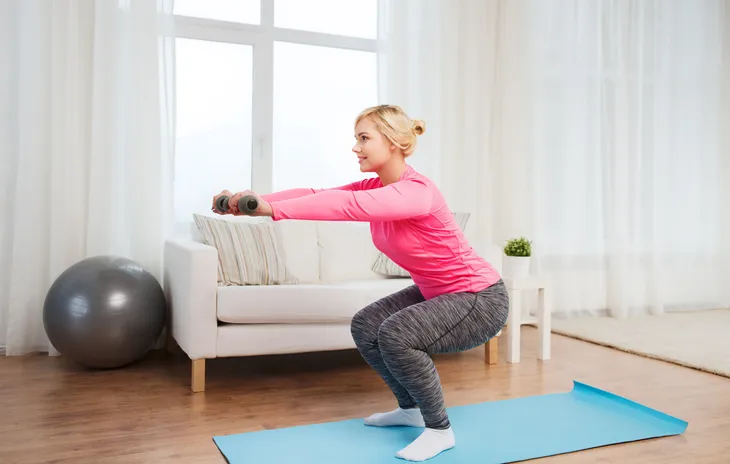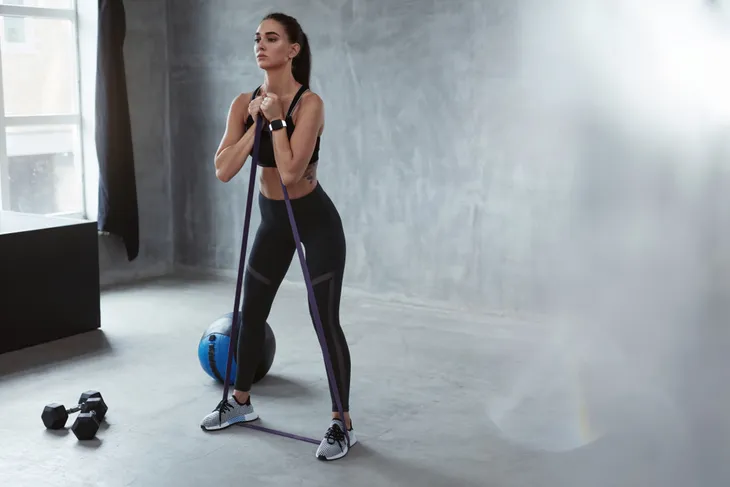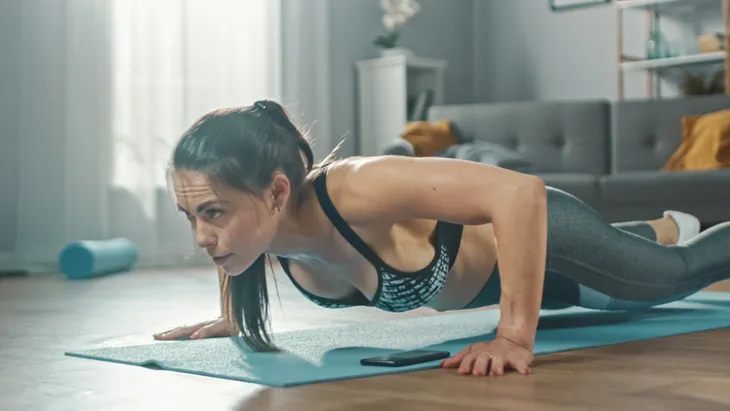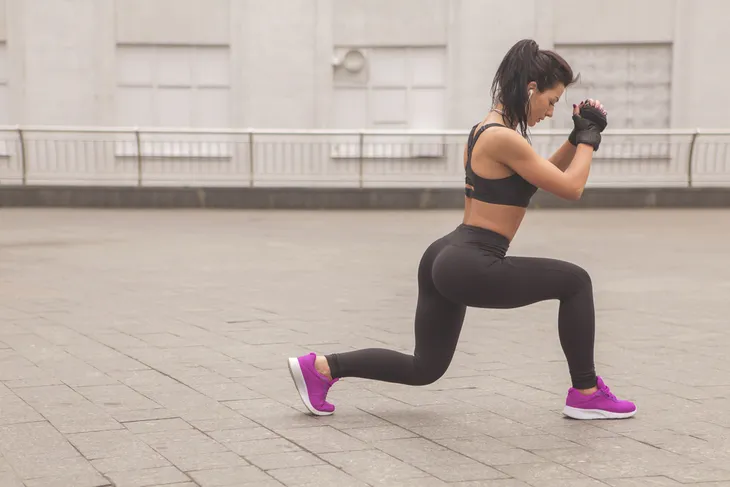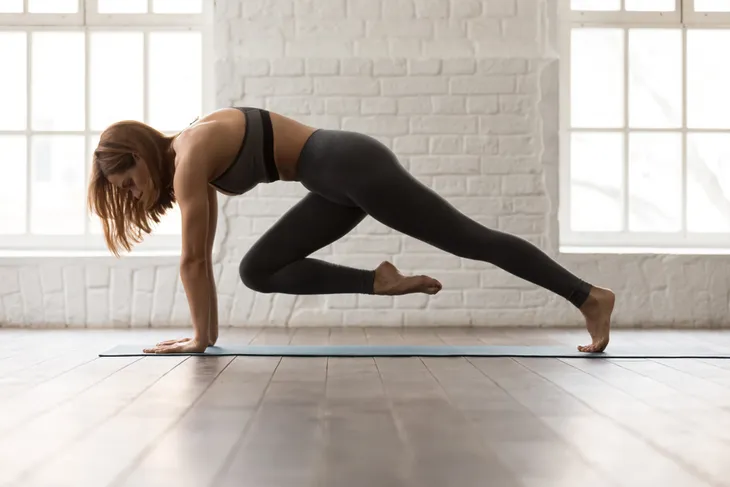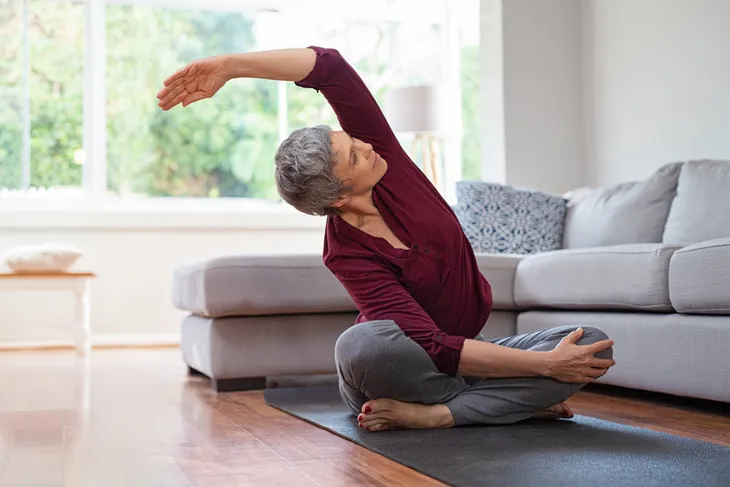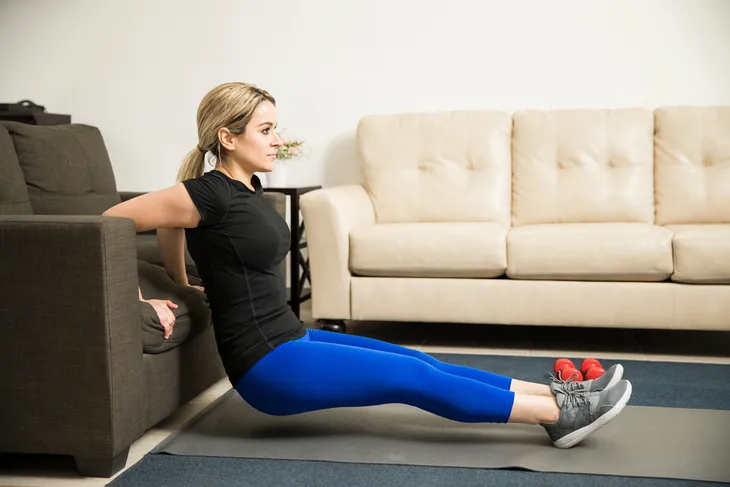You’ve committed to starting a regular workout routine. To save money and time, you decide to work out at home instead of going to the gym or joining a sports group. After making sure you have the right shoes and workout clothes, you look around your house and consider the space you have to workout. Does this sound familiar?
Getting in a full body workout in a tight space can be challenging, but not impossible. Follow this workout designed specifically for tight spaces and minimal equipment…
Routine at a Glance
For this workout you will need a radius that is big enough for you to lunge forwards, backwards, and sideways. Even though you are working out at home, wearing supportive footwear and proper workout attire is key. Not only does this prevent injuries and improve comfort, it also helps you get in the mindset of working out. Find an area free of distractions (except music)—watching TV can be distracting, which can reduce your intensity and focus, as well as attention to your form.
The equipment required for this workout is one set of heavier weights for lower body exercises, one set of lighter weights for upper body and exercises, and a medium resistance theraband (or resistance tube with handle). Don’t have any dumbbells? Household items can be substituted for weights. For example, soup cans could form a set of lighter weights. You can also make your own heavier weights by filling up bags with sand. Adjust the number of reps and sets depending on your goals and available time.
Warm Up
Just because you don’t have a line of treadmills or a fitness instructor in front of you to remind you of the importance of warming up, it doesn’t mean you can skip it—even at home! A warm up should prepare your body for the workout ahead by increasing circulation, improving mobility in restricted joints, and providing you time to mentally gear up for your workout.
How much is enough? If you’ve elevated your heart rate enough to feel invigorated (not exhausted) and have relieved any nagging areas, you’re ready to go. Typically, you should be able to complete this between 5- and 10-minutes. Perform the following gentle dynamic workout twice: 10 alternating side lunges, 30-seconds (or 30s) of jog on spot or high knees, 5 wall push ups, 10 body weight squats, and 5 shoulder presses without weight. Next, use a lacrosse ball or foam roller to gently encourage tight areas to release (avoid static stretching).
Overhead Dumbbell Squat
To perform the overhead dumbbell squat, pick up your light dumbbells (or none at all—simply raising your arms might be challenging enough) and extend them completely overhead. Here’s where it gets tricky: keeping your arms overhead, lower into a squat position, only going as far as you can while still keeping your spine neutral. Push through your heels and rise back to standing.
Common mistakes with this exercise include overarching the upper back in an effort to keep the arms above head. Instead, think about keeping your ribcage “closed” and allowing your arms to travel forward slightly (but not past your ears). Additionally, many people try to go as deep as a regular squat, which is too difficult for most people and can lead to back injury. For this exercise, having a mirror or window where you can see your reflection is handy if you’re not sure that you’re keeping your spine neutral.
Standing Band Reverse Flies
Using your theraband or resistance tube, grip it so that your hands are slightly wider than shoulder distance apart with your palms facing the ground. Stand with your knees slightly bent and feet firmly planted on the ground, imagining yourself sturdy enough to resist being toppled if someone tried to push you over.
Raise your arms until they are just lower than your shoulders. While staying still with the rest of your body, pull your arms hands away from each other to stretch the band out further. This pulling motion generates tension across your upper back, requiring it to work to pull and stabilize the band. Just like the first exercise, there is a significant tendency to arch one’s back to make the pulling motion easier. This only serves to reduce the focus on your upper back muscles, which is the goal of this exercise. Instead, think again about keeping your rib cage closed.
Cardio Blast
Now it’s time to elevate your heart rate! Alternating between bursts of cardio and strength training gives you the most bang for your buck; short cardio intervals allow you to work at a higher intensity and still free up time to perform the strength training exercises that keep the rest of your muscles strong. For this cardio blast, you can choose either the higher or lower impact option, depending on your unique considerations.
For the higher impact option, perform 30s of high knees, 30s of butt kicks, and 30s of bodyweight jump squats. If jump squats bother your knees, you can also try substituting 30s of jumping jacks. If you prefer a lower impact option, do 30-seconds of alternating side lunges, 30 seconds of bodyweight squats, and 30s of shadowboxing, all still guaranteed to raise your heart rate and have you sweating.
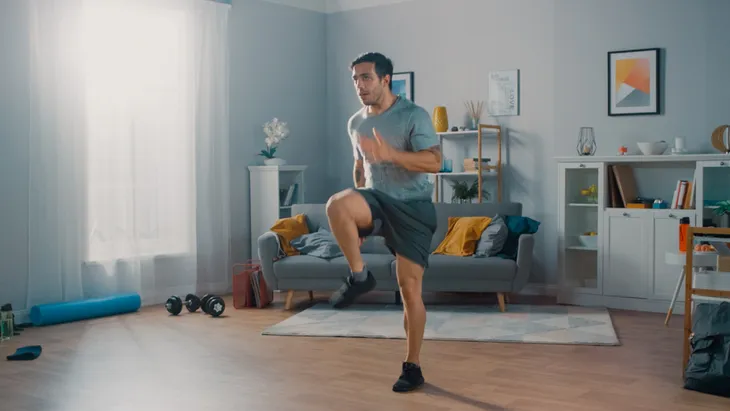 Shutterstock
ShutterstockPush-Up Variations
It doesn’t matter what your fitness level is, there is a push-up variation that’s right for you. This exercise helps build strength in your shoulders, pecs, back, and core muscles. For any of the push up variations, the same key principles about form hold true: never let your back sag (if you can’t stop it from sagging, choose an easier version or stop your set), push up until your shoulder blades are flat against your ribcage (you shouldn’t see “wings”), and focus on pushing evenly through both sides.
If you’re a complete beginner, perform your pushups against a wall, exaggerating the time it takes to lower yourself towards the wall. If that’s too easy, you can perform incline pushups against a chair. More advanced options include full pushups, mountain climber push ups (full push ups followed by two knee to chest raises), and uneven pushups (placing one hand on a book or slightly raised object to isolate that side).
Stationary Lunges
Stationary lunges are a practical way to work both legs independently in limited space and can be easily scaled up or down in difficulty depending on your fitness level. For beginners, bodyweight stationary lunges or stationary lunges with your upper body weights are a good place to start. More advanced exercises can use the heavier lower body weights.
A few notes on common errors in executing this exercise. First, watch your knees and ensure they stay in alignment with your second and third toe throughout the exercise (common to see them buckle inwards at the bottom of the movement). Second, avoid tilting forward as you lower yourself (imagine a pole running from your head to the floor that prevents you from leaning). Third, make sure to keep your hips level (use a mirror if possible), as there is a tendency to not stabilize as well on one side and to allow that hip to dip downwards.
Cardio Blast Two
Yep, it’s time to get that heart rate up again! This time, there’s a little twist: you will get to rest- briefly because the interval will be slightly longer. This cardio blast utilizes Tabata training, a type of high intensity interval training that lasts for 4-minutes in total—working you really hard for 20-seconds and then resting completely for 10-seconds.
You can be creative with your Tabata and use a variety of different exercises during the interval. Examples of higher impact exercise include tuck jumps, star jumps, jump squats, full burpees, sprinting in place, and side to side two foot hops. Lower impact work intervals could consist of marching quickly in place, body weight squats, alternating forward lunges, or modified burpees (instead of kicking your feet backwards, placing them back one at a time and also returning them one at a time to the starting position).
Plank Variations
The plank is one of the most versatile core exercises that can be quickly made easier or more difficult. Just like with the pushup, not allowing your back to sag and focusing on drawing your scapula flush against your upper back are important to get the most out of this exercise and prevent injury. This exercise is held for duration in time, but remember to stop as soon as you feel your form is lacking.
If you’re new to planking, try it from your knees. Get down on your forearms and knees and walk out as far you can with your elbows stacked under your shoulders and your back flat like a tabletop that’s parallel to the floor. If you’re more advanced, you can try planking from your toes or extended planks where your arms reach out further in front of you which intensify the difficulty of the exercise.
Deadlift into Shoulder Press
Before you start, practice the deadlift without any weights at all to help you learn the exercise. Stand a foot away from a wall with your back to it. Place your feet shoulder distance apart, knees slightly bent and then think about sticking your bum back, weight in your heels, until your bum hits the wall, keeping your back straight. This is called a hip hinge movement.
Putting it all together, perform the deadlift while holding the weight, return to standing and complete a shoulder press. Advanced exercisers have a few options. They can use their heavier lower body weights for the deadlift portion, switch to their upper body weights, and complete the shoulder press movement. Alternatively, they can split it up and perform the desired number of deadlifts with the heavier weights and then immediately follow it with shoulder presses with the lighter weights.
Cool Down
The cool down, like the warm up, is often rushed if not completely overlooked. Taking the time to bring down your heart rate, work on improved range of motion with warm muscles, and reflect on your workout is worth the time. Now that your body is really warm from the workout, you can take working on tight areas a little further by doing some more foam rolling followed by static or proprioceptive neuromuscular facilitation (PNF) stretching.
Static stretching involves holding a stretch in one position for 15- to 30-seconds. On the other hand, PNF stretching is more dynamic and involves contracting the muscle followed by static stretching. During your stretches, take a minute to reflect on your workout. How did it make you feel? What would you change for next time? Aim for at least 5-minutes of time devoted to cooling down.
Personalizing Your Routine
The exercises in this routine give you the tools to create an awesome workout, but it’s up to you to design the reps, sets, and intensity based on your goals and available time. If you’re new to working out or are coming back after a long time off, try performing each exercise just once for 12 to 15 reps before moving onto the next exercise. As your fitness increases, you can add another set of the exercise, for a total of two sets each exercise, before moving onto the next one.
Advanced exercises can set this workout up as an intense circuit by performing each exercise once and then repeating the list from the beginning, up to three times. You can also adjust it by adding more or less cardio intervals in and working in a lower rep range of 8 to 10 with heavier weights and more difficult variations of the exercises.



